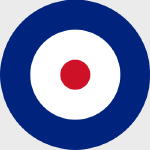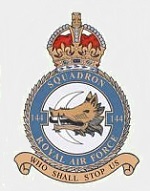Corgi AA28601 RAF Bristol Beaufighter TF.X Torpedo Bomber - No.144 Squadron, Banff, Aberdeenshire, Scotland, October 1944 (1:72 Scale)
"Who shall stop us"
- Motto of No.144 Squadron
 Developed as a private venture by the Bristol Aeroplane Company, the Beaufighter was a two-seat all-metal fighter using components from the Beaufort torpedo-bomber. First flown on July 17th, 1939, the Beaufighter eventually equipped 52 RAF squadrons, giving outstanding service during World War II, in particular as a night-fighter and torpedo-bomber (where the aircraft were affectionatey known as 'Torbeaus').
Developed as a private venture by the Bristol Aeroplane Company, the Beaufighter was a two-seat all-metal fighter using components from the Beaufort torpedo-bomber. First flown on July 17th, 1939, the Beaufighter eventually equipped 52 RAF squadrons, giving outstanding service during World War II, in particular as a night-fighter and torpedo-bomber (where the aircraft were affectionatey known as 'Torbeaus').
Entry into Fighter Command service came during August 1940 with the Fighter Interception Unit at Tangmere. The following month, five squadrons received the Mark 1F equipped with Mark IV Air Intercept radar for night-fighter duties although the type's first kill wasn't until November of that year. The Beaufighter continued as a night-fighter until 1943, and the last aircraft (a TT10) was not retired from RAF service until 1960, nearly 21 years after the type's first flight.
1941 saw the development of the Beaufighter Mk.IC long-range heavy fighter. This new variant entered service in May 1941 with a detachment from No. 252 Squadron operating from Malta. The aircraft proved so effective in the Mediterranean against shipping, aircraft and ground targets that Coastal Command became the major user of the Beaufighter, replacing the obsolete Beaufort and Blenheim.
Coastal Command began to take delivery of the up-rated Mk.VIC in mid 1942. By the end of 1942, Mk VICs were being equipped with torpedo-carrying gear, enabling them to carry the British 18-inch or the US 22.5-inch torpedo externally. The first successful torpedo attacks by Beaufighters came in April 1943, with No. 254 Squadron sinking two merchant ships off Norway.
The Hercules Mk XVII, developing 1,735 hp at 500 feet was installed in the Mk VIC airframe to produce the TF Mk.X (Torpedo Fighter) - commonly known as the "Torbeau." The Mk X became the main production mark of the Beaufighter. The strike variant of the "Torbeau" was designated the Mk.XIC. Beaufighter TF Xs would make precision shipping attacks at wave-top height with torpedoes or rockets. Early models of the Mk Xs carried metric-wavelength ASV (air-to-surface vessel) radar with "herringbone" antennae carried on the nose and outer wings, but this was replaced in late 1943 by the centimetric AI Mark VIII radar housed in a "thimble-nose" radome, enabling all-weather and night time attacks.
The North Coates Strike Wing (Coastal Command), based at RAF North Coates on the Lincolnshire coast, developed attack tactics combining large formations of Beaufighters on anti-flak suppression with cannon and rockets while the Torbeaus attacked on low level. These tactics were put into practice in mid 1943 and in a 10 month period 27,000 tonnes of shipping were sunk. Tactics were further adapted when shipping was moved from port during night hours. North Coates Strike Wing operated as the largest anti-shipping force of the Second World War, and accounted for over 150,000 tons of shipping and 117 vessels for a loss of 120 Beaufighters and 241 aircrew killed or missing. This was half the total tonnage sunk by all strike wings between 1942-45.
Pictured here is a 1:72 scale RAF Bristol Beaufighter TF.X torpedo bomber that was attached to No.144 Squadron, then deployed to Banff, Aberdeenshire, Scotland, during October 1944.
Sold Out!
Dimensions:
Wingspan: 9-3/4-inches
Length: 7-inches
Release Date: December 2019
 Historical Account: "On the Deck" - As one of the most capable twin-engined aircraft of WWII, the Bristol Beaufighter was originally developed as a heavy fighter variant of the company's Beaufort bomber, already in service with the Royal Air Force. The first examples were pressed into service as night fighters and whilst the aircraft proved to be a significant improvement over existing types, there was more to come from the mighty beau. As the aircraft received successive upgrades to make it more powerful and capable of carrying a greater array of offensive weaponry, the Beaufighter became a successful multi-role aircraft, with a particular flair for mounting hard hitting anti-shipping strikes into the North Sea, preventing Axis shipping from moving supplies back to Germany.
Historical Account: "On the Deck" - As one of the most capable twin-engined aircraft of WWII, the Bristol Beaufighter was originally developed as a heavy fighter variant of the company's Beaufort bomber, already in service with the Royal Air Force. The first examples were pressed into service as night fighters and whilst the aircraft proved to be a significant improvement over existing types, there was more to come from the mighty beau. As the aircraft received successive upgrades to make it more powerful and capable of carrying a greater array of offensive weaponry, the Beaufighter became a successful multi-role aircraft, with a particular flair for mounting hard hitting anti-shipping strikes into the North Sea, preventing Axis shipping from moving supplies back to Germany.
It was during one of these missions that Banff based Flying Officer Maurice Exton was awarded a DFC for outstanding flying skill and determination in the face of the enemy. Flying Beaufighter NE829 on October 9th, 1944, Exton and his squadron attacked a large convoy of enemy vessels off the coast of Norway, but his aircraft was hit by heavy flak from the ships. Damaging the aircraft's flight controls, causing it to almost flip onto its back, Exton wrestled with the Beaufighter's control column, bringing it back straight and level, before immediately pressing home his attack. He then nursed the damaged aircraft back to Banff, where he managed to land safely. Inflicting heavy damage on the enemy convoy they attacked, this incident says as much about the determination of the airmen of Coastal Command as it does about the resilience of the Bristol Beaufighter.


